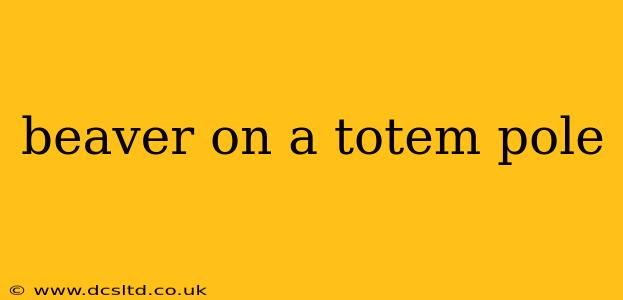The image of a beaver on a totem pole is far more than just a carving; it represents a complex tapestry of cultural beliefs, historical significance, and spiritual meaning, primarily within Indigenous cultures of the Pacific Northwest Coast of North America. Understanding the symbolism requires acknowledging the diverse traditions and interpretations across different First Nations. This article delves into the rich history and meaning behind this powerful symbol.
What Does a Beaver Symbolize on a Totem Pole?
The beaver's symbolism on a totem pole is multifaceted and often tied to specific clan histories and family lineages. Generally, however, the beaver is associated with several key attributes:
-
Industry and Resourcefulness: Beavers are renowned for their industrious nature, building intricate dams and lodges. This translates to totem pole symbolism as representing resourcefulness, diligence, and the ability to achieve great things through hard work and planning. The beaver's ability to transform its environment mirrors the transformative power of human action and innovation.
-
Strength and Perseverance: The beaver's powerful teeth and persistent work ethic convey strength and perseverance. They face challenges head-on, demonstrating resilience in the face of adversity. This makes the beaver a powerful symbol of enduring strength and the capacity to overcome obstacles.
-
Family and Community: The communal nature of beaver societies, working together to build and maintain their lodges, is another layer of meaning. The beaver represents the importance of family, community, and cooperation in achieving shared goals. Their societal structure reflects the values of unity and collective effort.
-
Transformation and Renewal: The beaver's dam-building activities alter the landscape, creating new habitats and changing the flow of water. This signifies transformation and renewal, reflecting cycles of growth and change within the natural world and the human experience.
What Does a Beaver Represent in Native American Culture?
It’s crucial to avoid generalizations when discussing Native American cultures. The interpretations of the beaver vary across different First Nations. For instance, some tribes may emphasize the beaver's industriousness, while others may focus on its connection to water and abundance. Understanding the specific cultural context is crucial to interpreting the symbolism accurately. Each totem pole tells a unique story rooted in a specific community's history and traditions.
Are Beavers Important in First Nations Cultures?
Yes, beavers held, and continue to hold, considerable importance in many First Nations cultures. Their fur was a vital resource for clothing and trade, while their meat provided sustenance. Their presence in the ecosystem was also intrinsically linked to the overall well-being of the communities. Their impact on waterways created vital habitats for other animals, influencing the success of fishing and hunting. Thus, the beaver's role extended beyond mere resource; it signified a balance and abundance within the natural world.
Why Are Beavers on Totem Poles?
The inclusion of a beaver on a totem pole is never arbitrary. It reflects the specific lineage, clan history, or significant events within a particular First Nations community. The beaver's presence conveys a message about the family's values, history, and connection to the natural world. Each carving is unique, telling a story only fully understood within the context of its creator's culture.
What Other Animals Are Common on Totem Poles?
Many animals appear on totem poles, each carrying its own symbolic meaning. Some common examples include:
- Eagle: Represents power, freedom, and spiritual connection.
- Wolf: Symbolizes leadership, loyalty, and family ties.
- Bear: Represents strength, protection, and motherhood.
- Raven: Symbolizes intelligence, trickery, and creativity.
The beaver, along with these other animals, contributes to the complex narrative conveyed through the art of totem pole carving, creating a rich tapestry of cultural heritage and spiritual meaning.
This article provides a general overview of the symbolism associated with a beaver on a totem pole. For a deeper understanding of specific interpretations, it is essential to consult the work of scholars specializing in First Nations art and culture, acknowledging the ongoing importance of respecting and learning from Indigenous knowledge systems.
